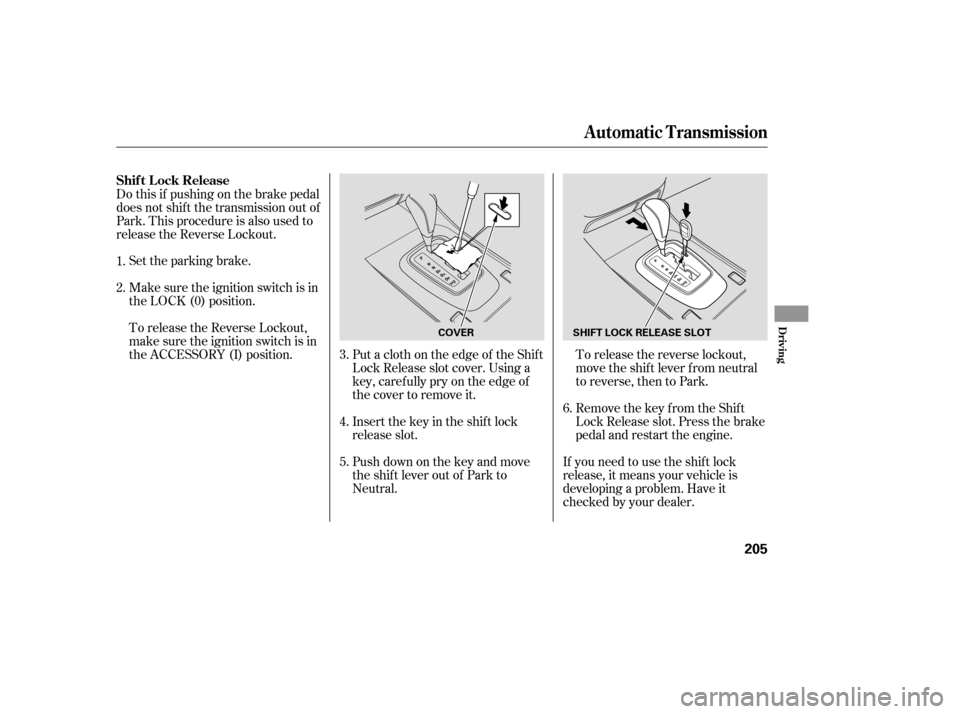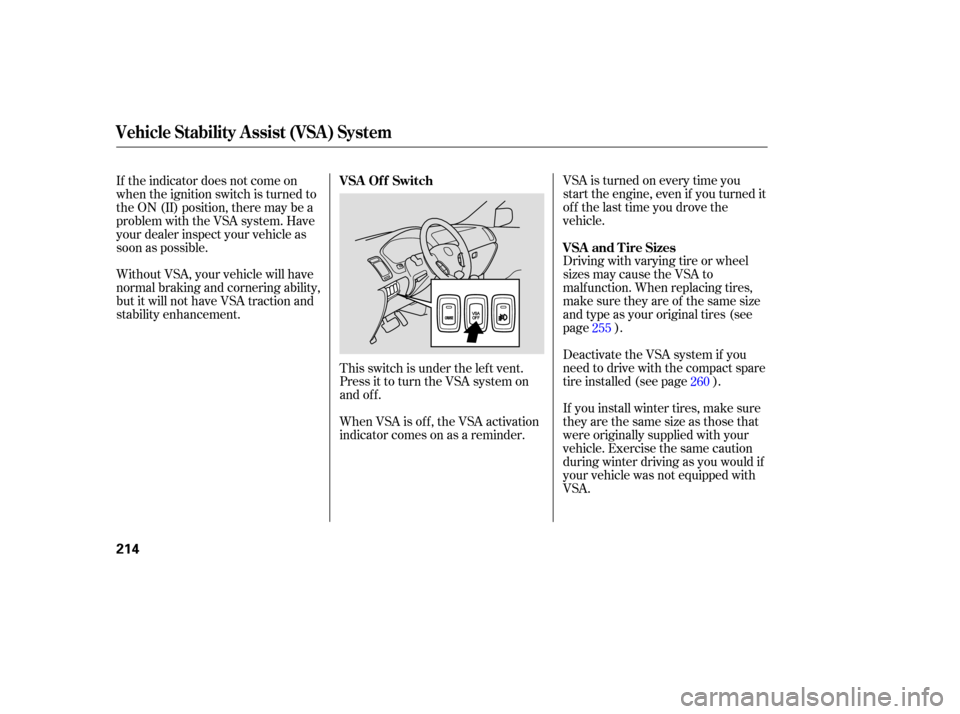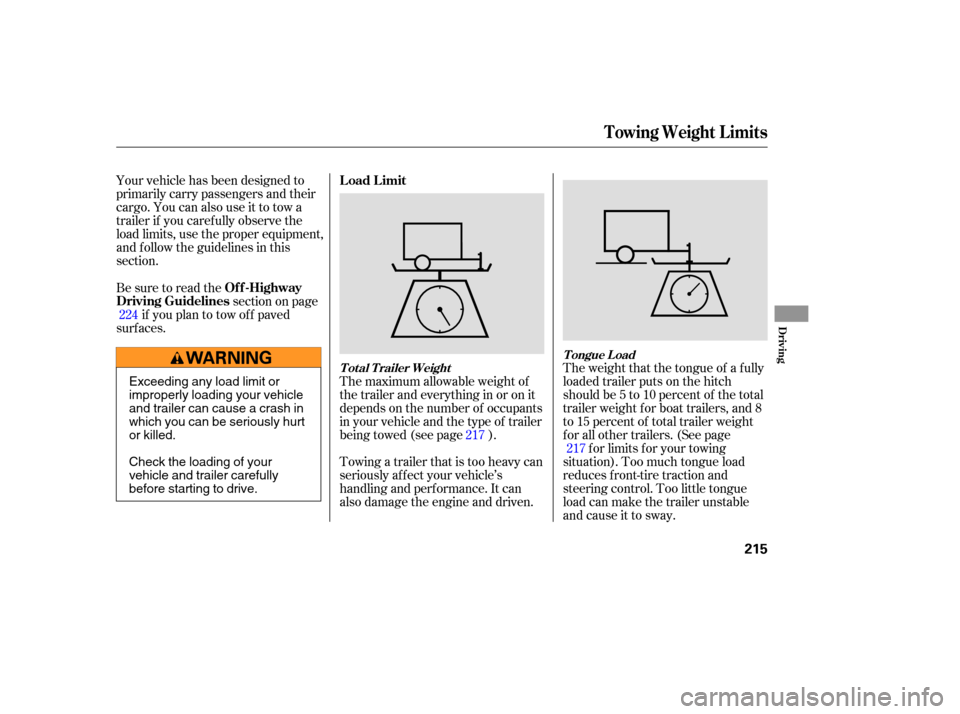engine Acura MDX 2006 Owner's Guide
[x] Cancel search | Manufacturer: ACURA, Model Year: 2006, Model line: MDX, Model: Acura MDX 2006Pages: 311, PDF Size: 3.94 MB
Page 206 of 311

Set the parking brake.
Make sure the ignition switch is in
the LOCK (0) position.
To release the Reverse Lockout,
make sure the ignition switch is in
the ACCESSORY (I) position. Put a cloth on the edge of the Shif tLock Release slot cover. Using a
key, caref ully pry on the edge of
the cover to remove it.
Insert the key in the shift lock
release slot.
Push down on the key and move
the shift lever out of Park to
Neutral.To release the reverse lockout,
move the shift lever from neutral
to reverse, then to Park.
Do this if pushing on the brake pedal
does not shif t the transmission out of
Park. This procedure is also used to
release the Reverse Lockout.
Remove the key from the Shift
Lock Release slot. Press the brake
pedal and restart the engine.
If you need to use the shif t lock
release, it means your vehicle is
developing a problem. Have it
checked by your dealer.
1.
2.
3.
4.
5.6.
Automatic Transmission
Shif t L ock Release
Driving
205
SHIFT LOCK RELEASE SLOT
COVER
Page 207 of 311

The variable torque management
4WD (VTM-4) system automatically
transf ers varying amounts of engine
torque to the rear wheels under
lower traction conditions.The vehicle must be stopped with
the engine running.
If more traction is needed when your
vehicle is stuck, or is likely to
become stuck, you can use the
VTM-4 lock button to increase
torque to the rear wheels. Move the shift lever to first (1),
second (2), or reverse (R) gear.
Press the VTM-4 lock button. The
indicator in the button comes on.
do
any of the f ollowing: Press the VTM-4 LOCK button.
Move the shift lever to D , D or
D.
Turn the ignition switch to the
LOCK (0) position.
The VTM-4 lock will temporarily
disengage when the vehicle speed
exceeds 18 mph (30 km/h). It will
automatically engage again as the
speed slows below 18 mph (30
km/h). The indicator in the button
will remain on.
To get unstuck, apply light pressure
to the accelerator pedal. Do not spin
the f ront tires f or more than a f ew
seconds. Because of the amount of
torque applied to the rear tires, they
should not spin. This is normal. If
you are not able to move the vehicle,
stop and reverse direction. 1.
2.
3.
54
3
To Engage the VTM-4 Lock To Disengage the VTM-4 Lock,
VTM-4 System
206
Do not continuously spin the f ront tires
of your vehicle. Continuously spinning
the f ront tires can cause transmission
or rear dif f erential damage.
Do not use the VTM-4 LOCK button on
dry, paved roads. Driving on dry,
paved roads with VTM-4 Lock ON may
damage the rear dif f erential when
making a turn. Strange noise and
vibration can also result.
Page 208 of 311

Each tire has its own pressure
sensor. If the air pressure of a tire
becomes signif icantly low, the
sensor in that tire immediately sends
a signal that causes the low tire
pressure indicator and the
appropriate tire on the tire pressure
monitor to come on. Your vehicle is equipped with a tire
pressure monitoring system (TPMS)
that turns on every time you start the
engine and monitors the pressure in
your tires while driving.When this indicator is on, one or
more of your tires is signif icantly
under inf lated. You should stop and
check your tires as soon as possible.Driving on a signif icantly under-
inf lated tire causes the tire to
overheat and can lead to tire failure.
Under-inf lation also reduces f uel
efficiency and tire tread life, and may
af f ect the vehicle’s handling and
stopping ability.
Although your tire pressure is
monitored, each tire should be
checked monthly, including the
spare.
Check the pressure with the tires
cold, af ter the vehicle has been
parked f or at least 2 hours.
Set to the recommended inf lation
pressure as specif ied on the vehicle
placard and in this owner’s manual
(see page ).
If you think you can saf ely drive a
short distance to a service station,
proceed slowly, and inf late the tire to
the recommended pressure shown
on the driver’s doorjamb.
If the tire is f lat, or if the tire
pressure is too low to continue
driving, replace the tire with the
compact spare tire.
252
Tire Pressure Monitoring System (TPMS)
Low Tire Pressure
Indicator
Driving
207
Page 211 of 311

Check the brakes after driving
through deep water. Apply the
brakes moderately to see if they f eel
normal. If not, apply them gently and
f requently until they do. Be extra
cautious in your driving.
Your vehicle is equipped with disc
brakes at all f our wheels. A power
assist helps reduce the ef f ort needed
on the brake pedal. The anti-lock
brake system (ABS) helps you retain
steering control when braking very
hard.
The hydraulic system that operates
the brakes has two separate circuits.
Each circuit works diagonally across
the vehicle (the lef t-f ront brake is
connected with the right-rear brake,
etc.). If one circuit should develop a
problem, you will still have braking
at two wheels.If the brake pads need replacing, you
will hear a distinctive, metallic
screeching sound when you apply
the brake pedal. If you do not have
the brake pads replaced, they will
screech all the time. It is normal f or
the brakes to occasionally squeal or
squeak when you apply them.
Constant application of the brakes
when going down a long hill builds
up heat and reduces their ef f ective-
ness. Use the engine to assist the
brakes by taking your f oot of f the
accelerator and downshif ting to a
lower gear. Resting your f oot on the pedal keeps
the brakes applied lightly, builds up
heat, and reduces their ef f ectiveness.
It also keeps your brake lights on all
the time, conf using drivers behind
you. Braking System DesignBrake Wear Indicators
Braking System
210
Page 214 of 311

When VSA activates, you may notice
that the engine does not respond to
the accelerator in the same way it
does at other times. There may also
be some unusual noise f rom the
modulator.When VSA activates, you will see the
VSA activation indicator blink. There
may also be some unusual noise
f rom the modulator.
If the VSA system indicator comes
on while driving, pull to the side of
theroadwhenitissafe,andturnoff
the engine. Reset the system by
restarting the engine. If the VSA
system indicator stays, or comes
back on while driving, have the VSA
system inspected by your dealer.
The VSA system cannot enhance the
vehicle’s driving stability in all
situations and does not control your
vehicle’s entire braking system. It is
still your responsibility to drive and
corner at reasonable speeds and to
leave a sufficient margin of safety. The vehicle stability assist (VSA)
system helps to stabilize the vehicle
during cornering if the vehicle turns
more or less than desired. It also
assists you in maintaining traction
while accelerating on loose or
slippery road surf aces. It does this
by regulating the engine’s output and
by selectively applying the brakes.
CONT INUED
VSA A ctivation Indicator VSA System Indicator
Vehicle Stability Assist (VSA) System
Driving
213
Page 215 of 311

Without VSA, your vehicle will have
normal braking and cornering ability,
but it will not have VSA traction and
stability enhancement.VSA is turned on every time you
start the engine, even if you turned it
off the last time you drove the
vehicle.
Driving with varying tire or wheel
sizes may cause the VSA to
malf unction. When replacing tires,
make sure they are of the same size
and type as your original tires (see
page ).
Deactivate the VSA system if you
need to drive with the compact spare
tire installed (see page ).
If you install winter tires, make sure
they are the same size as those that
were originally supplied with your
vehicle. Exercise the same caution
during winter driving as you would if
your vehicle was not equipped with
VSA.
When VSA is off, the VSA activation
indicator comes on as a reminder.
If the indicator does not come on
when the ignition switch is turned to
the ON (II) position, there may be a
problem with the VSA system. Have
your dealer inspect your vehicle as
soon as possible.
This switch is under the lef t vent.
Press it to turn the VSA system on
and off. 255
260
VSA Of f Switch
VSA and Tire Sizes
Vehicle Stability Assist (VSA) System
214
Page 216 of 311

Your vehicle has been designed to
primarily carry passengers and their
cargo. You can also use it to tow a
trailer if you caref ully observe the
load limits, use the proper equipment,
and f ollow the guidelines in this
section.The weight that the tongue of a f ully
loaded trailer puts on the hitch
shouldbe5to10percentof thetotal
trailer weight f or boat trailers, and 8
to 15 percent of total trailer weight
f or all other trailers. (See pagef or limits f or your towing
situation). Too much tongue load
reduces front-tire traction and
steering control. Too little tongue
load can make the trailer unstable
and cause it to sway.
The maximum allowable weight of
the trailer and everything in or on it
depends on the number of occupants
inyourvehicleandthetypeof trailer
being towed (see page ).
Towing a trailer that is too heavy can
seriously af f ect your vehicle’s
handling and perf ormance. It can
also damage the engine and driven.
Be sure to read the
sectiononpage
if you plan to tow of f paved
surf aces.
217
217
224
Towing Weight Limits
Load Limit
Off-Highway
Driving Guidelines
T ot al T railer Weight Tongue Load
Driving
215
Exceeding any load limit or
improperly loading your vehicle
and trailer can cause a crash in
which you can be seriously hurt
or killed.
Check the loading of your
vehicle and trailer carefully
beforestartingtodrive.
Page 224 of 311

When climbing hills, closely watch
your temperature gauge. If it nears
the red (hot) mark, turn the air
conditioning of f , reduce speed and, if
necessary, pull to the side of the
road to let the engine cool.
If the transmission shif ts f requently
while going up a hill, shif t to D3.
If you must stop when f acing uphill,
use the f oot brake or parking brake.
Do not try to hold the vehicle in
placebypressingontheaccelerator,
as this can cause the automatic
transmission to overheat.
When driving down hills, reduce
your speed and shif t down to D . Do
not ‘‘ride’’ the brakes.Crosswinds and air turbulence
caused by passing trucks can disrupt
your steering and cause trailer to
sway. When being passed by a large
vehicle, keep a constant speed, and
steer straight ahead. Do not try to
make quick steering or braking
corrections.
Always drive slowly and have
someone guide you when backing up.
Grip the of the steering wheel,
then turn the wheel to the left to get
the trailer to move to the lef t. Turn
the wheel to the right to move the
trailer to the right.
Follow all normal precautions when
parking, including putting the
transmission in Park and f irmly
setting the parking brake. Also, place
wheel chocks at each of the trailer’s
tires.If the vehicle’s tires slip when
retrieving a boat f rom the water,
shif t to f irst gear, and turn on VTM-4
Lock (see page ). Disengage
VTM-
4Lock as soon as the boat is
out of the water to prevent damage
to the VTM- 4system. 206
3
bottom
Towing a Trailer
Driving on Hills
Handling Crosswinds and Buf f et ing
Backing UpParking Ret rieving a Boat
Remember, it
takes longer to slow down and
stop when towing a trailer.
Driving
223
Page 226 of 311

Before you leave the pavement, be
sure to do all scheduled maintenance
and service, and inspect your vehicle
f or any problems. Pay special
attention to the condition of the tires,
and check the tire pressures.
After you return to the pavement,
caref ully inspect your vehicle to
make sure there is no damage that
could make driving it unsaf e.
Recheck the condition of the tires
and the tire pressures.
The route presents limits (too steep
or bumpy roads). You have limits
(driving skill and comfort). And your
vehicle has limits (traction, stability,
and power).
Driving of f -highway can be
hazardous if you f ail to recognize
limits and take the proper
precautions.Forbettertractiononallsurfaces,
accelerate slowly and gradually build
up speed. If you try to start too fast
on wet soil, mud, snow, or ice, you
might not have enough traction to
get underway, and you may dig
yourself a hole. Starting with the
shif t lever in second (2) gear will
help you have a smoother start on
snow or ice.
Keep in mind that you will usually
need more time and distance to
brake to a stop on unpaved surf aces.
Avoid hard braking. Do not ‘‘pump’’
the brakes; let the anti-lock braking
system pump them f or you.
Debris in the road can damage your
suspension or other components.
Because your vehicle has a high
center of gravity, driving over a large
obstacle, or allowing a wheel to drop
into a deep hole can cause yourvehicle to tip or roll over.
If you can’t clearly see all conditions
or obstacles on a slope, walk the
slope bef ore you drive on it. If you
have any doubt whether or not you
can saf ely drive on the slope, don’t
do it. Find another route.
The water is not deep enough to
cover your wheel hubs, axles, or
exhaust pipe. You could stall and
not be able to restart your engine.
The water can also damage
important vehicle components.
If you are driving up a hill and f ind
that you cannot continue,
. Your vehicle could roll
over. Slowly back down the hill,
f ollowing the same route you took up
the hill.
Bef ore driving through water, stop,
get out if necessary, and make sure
that:
do not try to
turn around
Check Out Your Vehicle
Remember Accelerating and Braking
Avoiding ObstaclesDriving on Slopes
Crossing a Stream
Of f -Highway Driving Guidelines
Driving
225
Page 227 of 311

The banks are sloped so you can
drive out.
The water is not f lowing too f ast.
Deep rushing water can sweep you
downstream. Even very shallow
rushingwatercanwashthe
ground f rom under your tires and
cause you to lose traction and
possibly roll over.
The banks and surf ace under the
water provide good traction. The
water may hide hazards such as
rocks, holes, or mud.
If you decide it is saf e to drive
through water, choose a suitable
speed and engage the VTM-4 Lock.
Proceed without shif ting or changing
speeds, and do not stop the vehicle
or shut of f the engine.
After driving through water, test
your brakes. If they got wet, gently
‘‘pump’’ them while driving slowly
until they operate normally. If the water is deeper than the wheel
hubs, some additional service may
be required. This service is not
covered by your warranties.
If you get stuck, engage the VTM-4
Lock (see page ). Caref ully try to
go in the direction (f orward or
reverse) that you think will get you
unstuck. Do not spin the tires at high
speeds. It will not help you get out
and may cause damage to the
transmission or VTM-4 system.
If you are still unable to f ree yourself ,
your vehicle is equipped with f ront
and rear tow hooks designed f or this
purpose.
Use a nylon strap to attach the MDX
to the recovery vehicle and caref ully
take out the slack in the strap. Once
the strap is tight, the recovery
vehicle should apply f orce.
Remember that the recovery vehicleneeds good traction to avoid
becoming stuck, too.
You should never use a jack to try to
get unstuck. Your vehicle could
easily slip of f the jack and hurt you
or someone else.
You may be able to safely tow a
lightweight trailer (such as a
motorcycle or small tent trailer) of f -
road if you f ollow these guidelines.
Do not exceed 1,000 lbs (450 kg)
or a tongue weight of 100 lbs (45
kg).
Slow down if you encounter bumps
or other obstacles. Allow extra room f or starting,
stopping, and turning. Stay on smooth, level dirt roads,
and avoid driving in hilly terrain.
206
If You Get Stuck
Towing a Trailer Off-Road
Of f -Highway Driving Guidelines
226